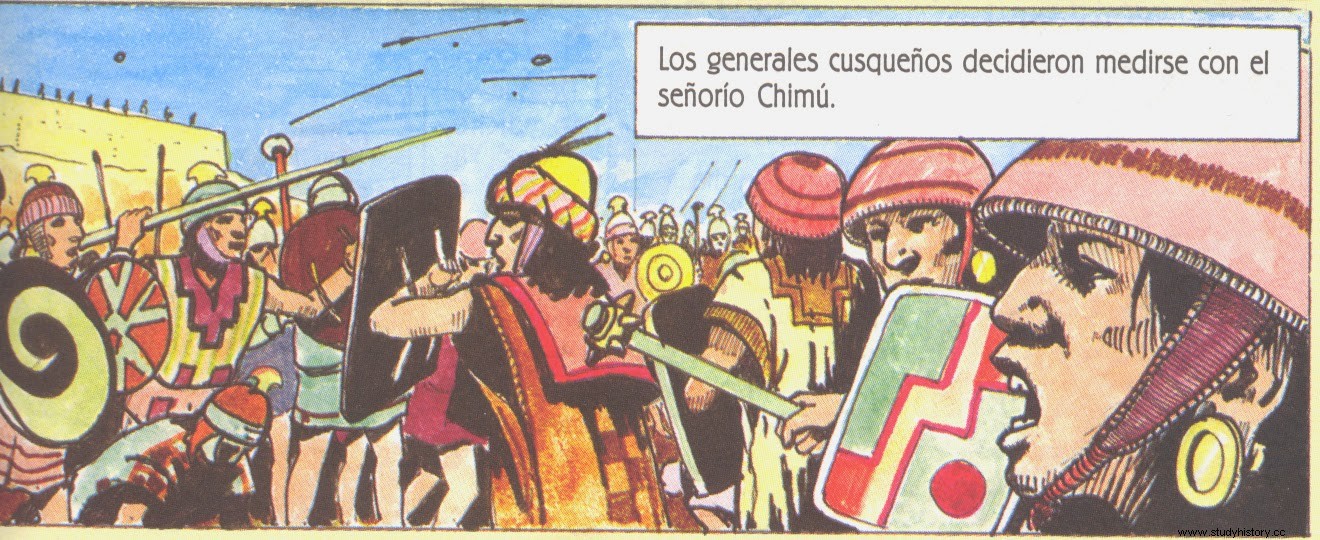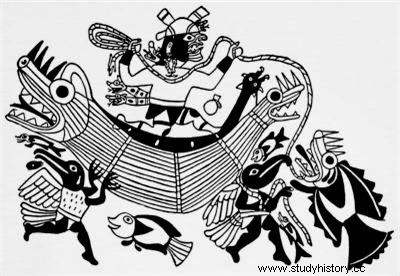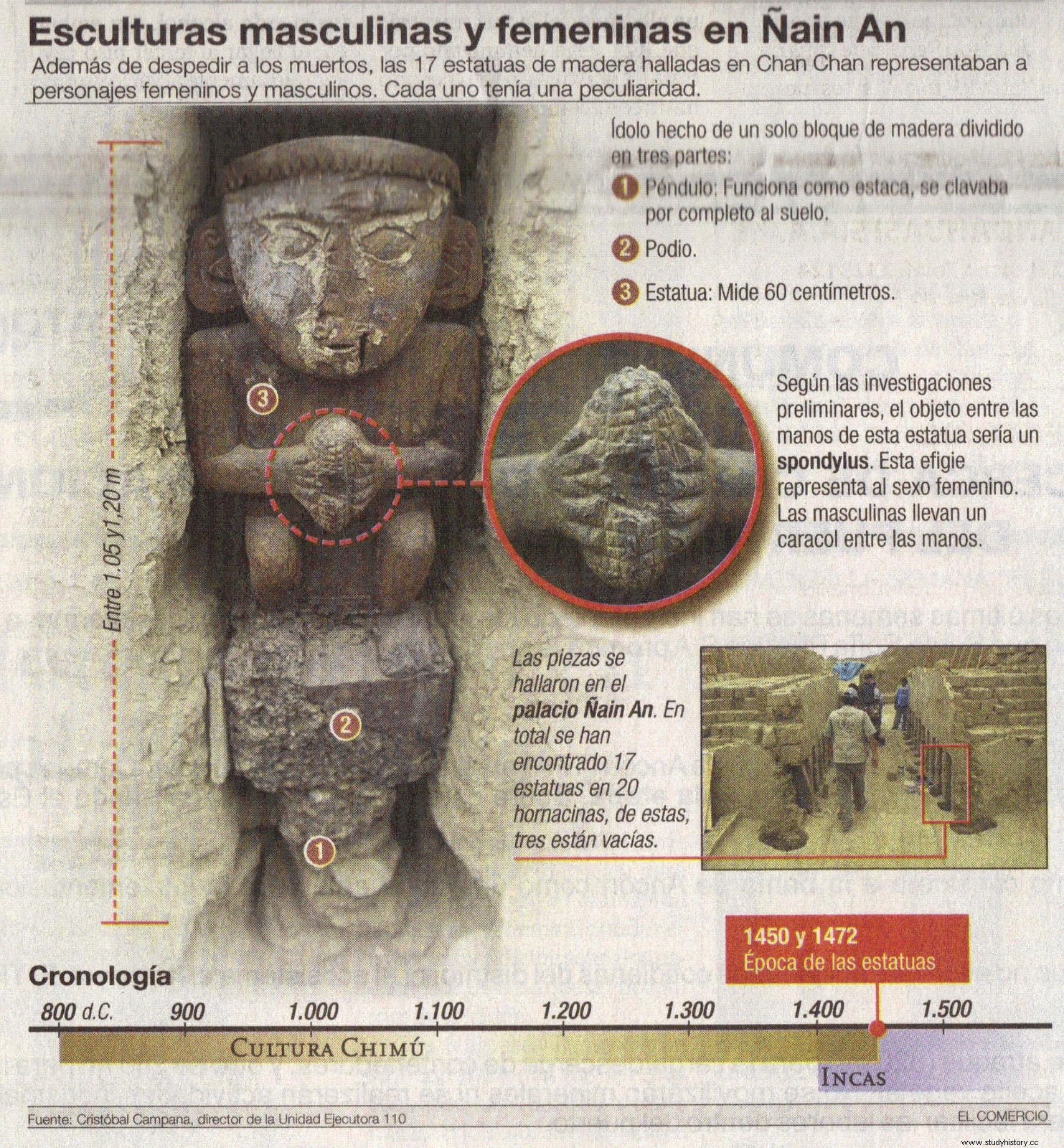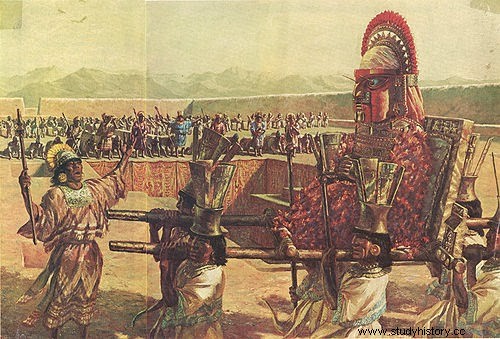The Great Chimú developed on the north and central coast, from Tumbes to Carabayllo (Lima). It was a monarchical-centralist state during the reign of the Cie-quich called by the Incas Chimo Capac who came to control a tributary population of approximately 750,000 inhabitants, mostly agricultural producers and fishermen. Between 10% and 15% of its population resided in the cities and dedicated themselves to commercial and artisanal administrative functions, which allowed for strict control of the subjugated regions, both in terms of labor force and economic resources.
 Extent of the Chimú KingdomThe Chimú nobility, of Mochica origin and imperial aspirations, imposed respect for private property and individualized right. All robbery was a sacrilege attack against property, therefore, it was investigated by the fixI (warriors) until the culprit was found and executed. Or, if not, to raze the entire ayllu from which the alleged offender came from in retaliation. The so-called "audiencias" or office rooms for such judicial proceedings, in defense of the private property of the great owners (the nobility), were the most imposing buildings in any city of the Great Chimú. In this way, the Chimú nobility, under the leadership of the Ciequich or monarch, was able to concentrate greater wealth and control large areas of cultivation, hydraulic systems and labor force, which made an efficient and violent process of expansion possible. This process reached its peak with the ciequich Minchan Caman (great conqueror).
Extent of the Chimú KingdomThe Chimú nobility, of Mochica origin and imperial aspirations, imposed respect for private property and individualized right. All robbery was a sacrilege attack against property, therefore, it was investigated by the fixI (warriors) until the culprit was found and executed. Or, if not, to raze the entire ayllu from which the alleged offender came from in retaliation. The so-called "audiencias" or office rooms for such judicial proceedings, in defense of the private property of the great owners (the nobility), were the most imposing buildings in any city of the Great Chimú. In this way, the Chimú nobility, under the leadership of the Ciequich or monarch, was able to concentrate greater wealth and control large areas of cultivation, hydraulic systems and labor force, which made an efficient and violent process of expansion possible. This process reached its peak with the ciequich Minchan Caman (great conqueror).In such an expansive process (1370 -1461), the Great Chimú conquered Lambayeque or the Sicán culture, which later influenced the dominator's culture. The Sicán culture was quite old and more artistically and technologically developed, compared to the Chimú. The Chimú nobility reached its apogee when they took control of the numerous workforce and the territories, during the administration of Minchan Caman, into whose hands about 50% of the fertile lands of the Peruvian coast passed; while in the Andes the Chancas and Incas began to expand. The Chimú empire tried to face the Inca advance, drawing a defensive line with the fortress of Paramonga and the hasty construction of a great wall along the Santa River; but both were insufficient to contain the expansion of Cusco. The Incas blocked the waterways of the Chimu in the northern highlands, which weakened the economy of the coastal empire and facilitated their conquest. Minchan Caman took refuge in the city of Chan Chan where, it is said, he was able to resist Tupac Yupanqui's siege for six months until he had to accept his defeat. Michan Caman was the last ruler of the Chimú empire, but when he fell to the Incas he swore allegiance to the Tahuantinsuyo, to preserve his privileges. It was studied by Max Uhle in 1902 and its capital city was Chan chan (sun-sun)

HISTORY AND ORIGIN
It is affirmed that the Chimú kingdom had ten rulers, although there is only a nominal record of four of them:Tacainamo, the founder, who according to legend would have come to the Moche valley from "beyond the seas" to rule these lands; Guacricur (unified the nearby valleys) and Naucempinco, (began the true conquest and extension reaching the north to Pacasmayo and the south to the Santa River) and the last king called Minchancaman, reached Tumbes to the north and Carabayllo. by the south. Towards 1470, the Incas of Cusco under the command of the auqui Tupac Yupanqui defeated the Chimúes. The Inca conquest ended with the capture and transfer to Cusco of the last ruler named Minchancaman. Likewise, the Incas transferred to Cusco some nobles and many artisans, as well as gold and silver that later served to adorn the Temple of the Sun with statues and friezes.Mythical origin. The legendary origin of Chimu is related to the legend of Tacaynamo, a civilizing hero who founded the city of Chanchan and whose descendants hereditarily ruled the kingdom of Chimú.Royal origin. Archaeologists maintain that the real origin of Chimu is in the influence of the Waris in the region, which was mixed with elements of local cultures such as:Moche and Lambayeque.

ECONOMY, SOCIETY AND STATE IN CHIMÚ The development of intensive irrigated agriculture, under the control of the State through rural urban centers, was the main characteristic of the Chimú economy. Hydraulic complexes were built to irrigate several valleys, which made it possible to rationalize the use of water by controlling government on aqueducts and ditches (Tayrni, Ascope, etc.). The advanced hydraulic engineering of Chimú can be appreciated in the following complexes:1. Chicama-Moche complex, around the channel of La Cumbre.2. Lambayeque Complex, which joins the rivers La Leche, Lambayeque, Reque, Zaña and Jequetepeque.3. Fortaleza Complex, which interconnected the valleys of Pativilca, Paramonga and Supe.4. Rímac-Chillón Complex, up to Maranga.5. Lurín-Cañete-Pisco complex, which was also used by the chinchas.
 Señor Chimú-Chimucapac
Señor Chimú-Chimucapac 
Among other Chimú hydraulic techniques, we also have the pukios, gigantic wells for capturing water, such as Kiriwac, Pukio Larrea and Pukios Alto and Bajo. They also built reservoirs to contain the water of the rivers and sunken farms called huachaques. These made it possible to take advantage of the underground water for the cultivation of cattails."The huachaques It was an ingenious agricultural system that was practiced in ancient Peru in the coastal region to gain soil in the deserts, removing the materials until they found moisture at the level of the water table. Agriculture in these sunken farms is only fed with water from the subsoil. This crop does not require irrigation.

There are sunken farms in the citadel of Tschudi, around Cayhuac, Huachaque Chico and Grande or of impressive extension such as the Pampas de Alejandro of 580 hectares, which cover from the huaca El Higo to the spa of Buenos Aires and the current boundary of the university city of Trujillo . The huachaques structured an important modality -traditional technology- of agricultural exploitation, which takes root at least since the formative period in the aforementioned Moche valley, through the Caballo Muerto complex with more than a dozen ceremonial temples (...) Supported primarily through the use of cultivation in sunken orchards fed by the level of the water table" (Watanabe - 1995). Thanks to this complex hydraulic technology, the Chimú lords were able to expand the cultivation areas under their control and incorporate a larger tributary population. They also practiced trade:exchange of copper axes , made by them, with various regions (indirect exchange). For example, with Guayaquil, from where they brought shells. They promoted the construction of roads and preserved those created by the waris. These extended from Ecuador to Chincha. Another complementary economic activity was fishing where rustic boats were used, such as the caballitos de totora, which are still used today by artisanal fishermen from the north. They also practiced hunting, although this activity was reserved for the nobility as a recreational activity.

CHIMU SOCIETY Chimú society had social differences at the top of which was the proprietary nobility, headed by the Ciequich and made up of local lords or alaec (nobles), the fixl or military and the pixllca or merchants. It was an aristocratic, slave-owning and warrior society. Their social statuses are difficult to determine due to the loss of the language. When the Incas conquered them, they imposed their language, for example:they chose to call the conquered king Chimú Cápac. The base of the social pyramid was the ayllus, who worked under the leadership of a paraeng. It was also made up of the enslaved sectors (converted into runes) during the wars unleashed by the Chimú and also the prisoners or piñas, who did not always accept their subjugated condition since they were constantly struggling to solve the problems that overwhelmed them." In the culture Chimú the ruling and powerful class subdued the paraéng or vassals and domestic servants and frogs.The marked difference of classes or social groups between the high nobility deeply separated from the people, with little or no social mobility, appears ideologized by the legend:the Dominant elite has divine origin by descending from two major stars; on the other hand, the plebs come from two stars of lesser importance" (Watanabe - 1995). "The plundering forms that stood out the most were the slaves, because the masters exercised general ownership over work, production and men. There were forms of 'leasing' land to the privileged curacas (alaec), but the owners perceived the more crops or products" (Vargas Salgado-1987) .
 Chimu Priest
Chimu Priest 
The Chimú nobility imposed dominance through a repressive state that used military force in defense of the properties. Religion also served as an ideological instrument that fostered fear and respect for the gods. For example, through ceremonies where animals and people were sacrificed using gold knives (Tumi) (such as the one found in the hacienda of Illimo and Batán Grande, Lambayeque). The Tumi is a ceremonial knife about 30 cm high made using the technique laminate inlaid with precious stones. In 1988, a copy of this work was stolen from the Museum of Anthropology and History of Pueblo Libre, located in Lima. They also exercised control over the water and even the production of chicha de jora (a drink widely used throughout the region until today). The massive production in the fulling mills and ollones of Manchan (Casma) was under the administration of the State.
CHIMU CULTURAL ADVANCE The Chimú expansion allowed the nobility to centralize resources, labor and new craft technologies, which diversified the Chimú cultural manifestations. The central nobility used certain activities for their exclusive benefit, such as urban architecture, goldsmithing, mural painting and plumeria (they used duck feathers, as well as other birds from the Amazonian tropics). The urban architecture, mainly intended for the ruling classes of the great centers of power, stands out for its luxurious residences decorated with friezes in high and low relief and fine mural paintings. The houses of the popular sectors were simple buildings of thatch and equipped with an exterior patio with a sloping roof on two sides to deflect solar radiation and achieve a cool environment.

"In the Chimú constructions, the major problems they had to respond to were derived from the use of mud, having to cover spaces with a span of 2 to 3 meters. They made lintels and flat arches, inventing a series of ingenious solutions. Only in this way could they achieve such stable and consistent constructions with unstable materials. To build flat roofs with mud and concrete, first the very resistant enclosures or cubicles were made, then they were filled with dry sand, medium-sized stones and an upper layer of coarse sand, forming a filling that, when subjected to the forces of gravity, created thrusts towards the walls, avoiding deformation. of these" (Campana - 2000).
 friezes on the walls of chan chan "All the immense constructions were made based on the labor force of artisans, builders, peasants, frogs, who prepared the clay, adobes, adobones or lintels, elaborated in the form of a "pottery" pressed "in situ" to cover a span of 2.40 m. Its weight exceeds 3 tons, it is made with the most clayey and arid mud chosen and calculated (P. Rivero), Chan Chan". (Campana - 2000). The Chimú capital was the citadel of Chan Chan with 25 km2 of buildings. It had 10 neighborhoods with marked social differences. The huacas of Apurlec, Pacatnamú, Purgatorio, Huaca Pintada, Huaca Dragón, etc. were also built.
friezes on the walls of chan chan "All the immense constructions were made based on the labor force of artisans, builders, peasants, frogs, who prepared the clay, adobes, adobones or lintels, elaborated in the form of a "pottery" pressed "in situ" to cover a span of 2.40 m. Its weight exceeds 3 tons, it is made with the most clayey and arid mud chosen and calculated (P. Rivero), Chan Chan". (Campana - 2000). The Chimú capital was the citadel of Chan Chan with 25 km2 of buildings. It had 10 neighborhoods with marked social differences. The huacas of Apurlec, Pacatnamú, Purgatorio, Huaca Pintada, Huaca Dragón, etc. were also built. Walls over 3m high As for ceramics and metallurgy, as has already been said, the Chimúes continued the activities developed by the Lambayecanos (the Sicán culture). Later, with the Inca conquest of the Chimú, the Cusco nobility used these techniques of the Chimú artisans for their own benefit, that is, to decorate the temple of the sun.
Walls over 3m high As for ceramics and metallurgy, as has already been said, the Chimúes continued the activities developed by the Lambayecanos (the Sicán culture). Later, with the Inca conquest of the Chimú, the Cusco nobility used these techniques of the Chimú artisans for their own benefit, that is, to decorate the temple of the sun.The Chimú had the main divinity to the Moon, called Yes , to whom they sacrificed children under 5 years of age. The moon headed the Chimu deities and had a temple. In order of importance followed the sun, the constellations and the sea, called ni. The different sanctuaries that were found both in urban centers and in rural areas also completed the universe of gods. The sovereign was considered a deity. The cult of the ancestor was widespread throughout the population.

They also worshiped stone idols called Alaecpon. The Chimu coincided with the Incas in the practice of Orphism, that is, the veneration of the dead. For this reason, the nine noble neighborhoods that made up the central core of Chan-Chan were organized around the cult of dead monarchs. Their relatives continued to live in the palace surrounding the tomb, variegated with golden offerings, ceramics and buried corpses, following a magical-religious order. The Cusco conquerors assimilated the funerary decoration of the Chimú for the mummies of their own Incas. "These ideas and practices of the cult of the dead ancestors have ancestral roots in the Andean world. .Identifies the citizen of high "status", the average man and to the common low-income population, sepulchral objects have been humbly renewed, sacrificing small amounts of animals or promoting the elite the impressive cult of the royal mummy, where hundreds of human victims are sacrificed.Although it differs in its means of expression, the underlying attitude of respect towards the deceased congener" (Watanabe -1995). Chimú pottery was characterized by the production of vessels with globular shapes and with stirrup-handles made with molds. Other pieces preserved the Wari-influenced bridge handle and generally had a smoky surface. Globular shape and there are also double huacos. Ceramics with an anthropomorphic, zoomorphic, phytomorphic profile, with a single moldboard and an intermediate handle between the stirrup neck and the bridge neck and with a flat base. They did not achieve supremacy because the greats in metallurgy were the Lambayeque. They knew the technique of:hammering, embossing, rivets, welding, gold, silver, lamination, filigree, etc. The most representative pieces are:The Tumi:Found in the town of Illimo (Lambayeque), The gold gloves, the Vicus mask, They used predominantly:gold, silver and copper.
METALLURGY They developed a great technique, for which they are considered the best in Pre-Columbian America. We have as an example the ceremonial knife or Tumi, also ceremonial vessels and canes inlaid with precious stones, funerary masks, rings, etc. Hammered, laminated, gilded techniques. They worked gold, silver, copper, bronze. The Chimu goldsmiths embellished Cusco.
 Chimú art infographic
Chimú art infographic 